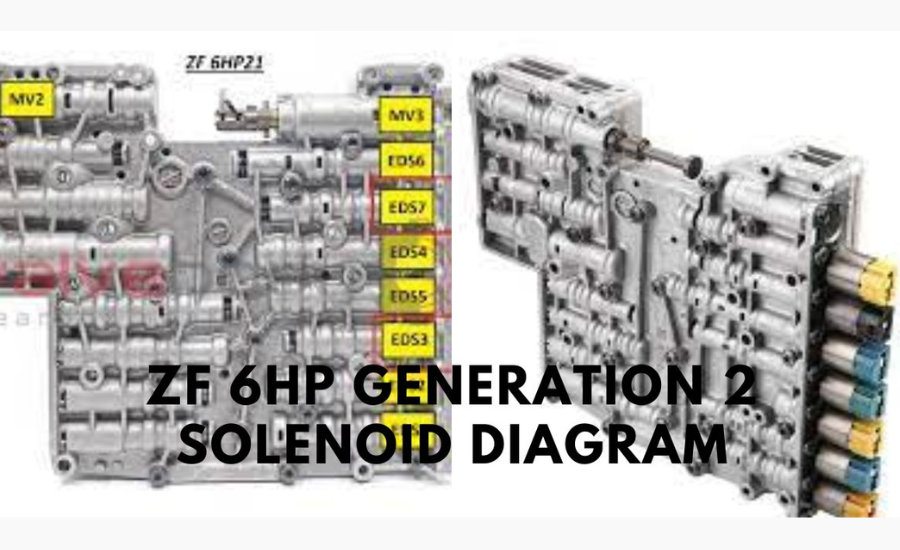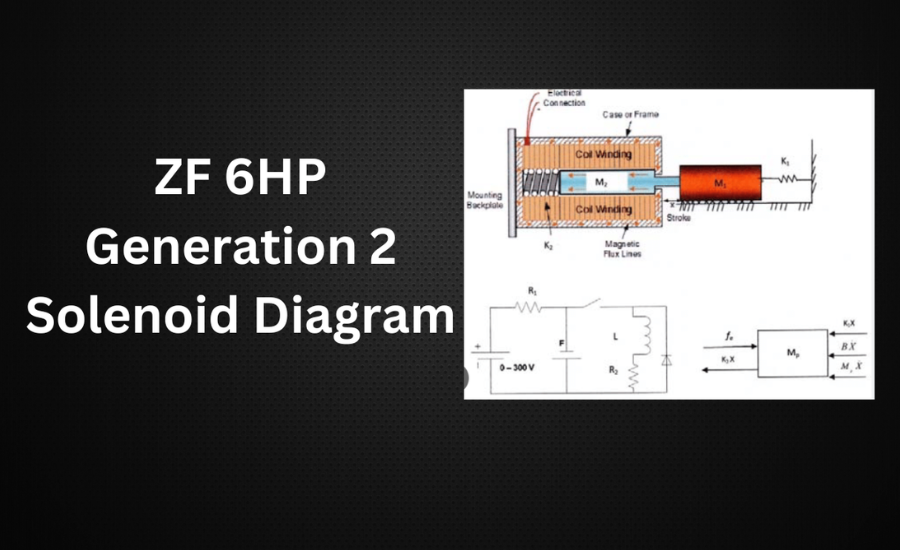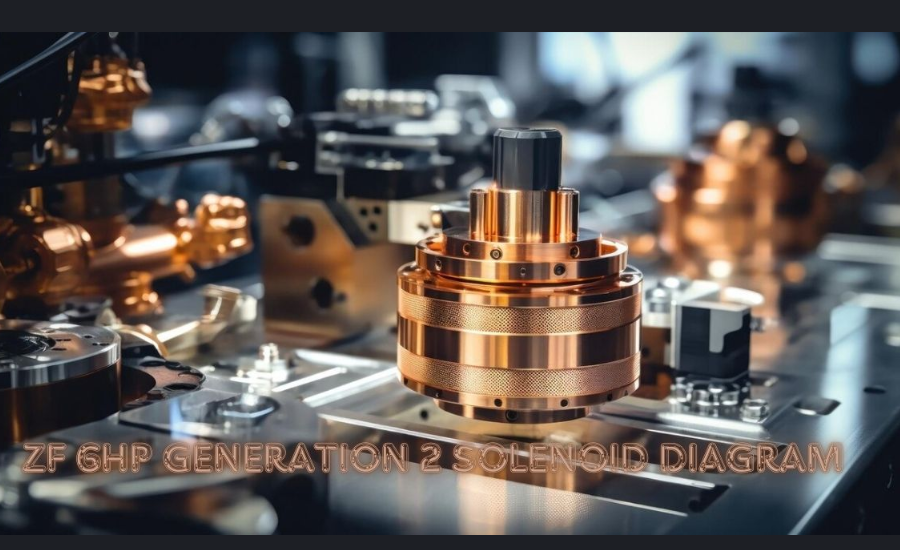As you explore the intricacies of automotive transmission systems, the ZF 6HP Generation 2 transmission is likely to come into focus. This transmission is celebrated for its exceptional reliability and robust performance, making it a common choice for a wide range of vehicles. Even the most reliable systems can encounter problems as time goes on. This is where solenoids come into play. These seemingly small but vital components are integral to the proper functioning of the transmission. They help manage the shifting of gears, ensuring that transitions are smooth and that the transmission operates efficiently. Understanding the ZF 6HP Generation 2 solenoid diagram is crucial for diagnosing problems and maintaining optimal performance. By delving into the specifics of this diagram, you can gain valuable insights into how these solenoids work, how to identify potential issues, and how to ensure your transmission continues to perform at its best.
Understanding Solenoids and Their Role in Automatic Transmissions

Solenoids are integral components in automatic transmissions, such as the ZF 6HP Generation 2. These sophisticated electromechanical devices are responsible for regulating the flow of hydraulic fluid within the transmission system, which in turn influences gear shifting and overall vehicle performance.
When an electrical current flows through a solenoid’s coil, it generates a magnetic field. This magnetic field is crucial for controlling various transmission elements by engaging or disengaging specific components. This precise control mechanism allows for accurate management of power transfer from the engine to the wheels, ensuring that the vehicle operates smoothly and efficiently.
In practical terms, solenoids function similarly to valves. They are essential for managing hydraulic pressure and facilitating smooth gear transitions. Without the proper operation of solenoids, gear shifts could become harsh and unpredictable, significantly affecting driving comfort and vehicle performance.
Regular maintenance and understanding of solenoids are critical for preserving a seamless driving experience. A faulty solenoid can cause irregular shifting patterns, diminished performance, or even complete transmission failure. Thus, comprehending how solenoids work and ensuring their proper function is vital for any vehicle owner who seeks to keep their transmission system in top condition.
Various Solenoids in the ZF 6HP Generation 2 Transmission
The ZF 6HP Generation 2 transmission incorporates several distinct types of solenoids, each with a specific role crucial to the transmission’s functionality. These electromagnetic components are essential for regulating fluid dynamics and managing various transmission operations.
Pressure Control Solenoids
One of the main solenoids used is the pressure control solenoid. This device adjusts hydraulic pressure to facilitate smooth gear shifts. By responding to changes in engine load and vehicle speed, it ensures that shifts are executed smoothly and efficiently.
Shift Solenoids
Another important solenoid is the shift solenoid, which governs the engagement of clutches and brakes to effectuate gear changes. Its precise operation is vital for achieving seamless gear transitions, which contributes significantly to a smooth driving experience.
Torque Converter Lock-Up Solenoids
Additionally, torque converter lock-up solenoids play a role in optimizing fuel efficiency, particularly during highway driving. By locking the torque converter at certain speeds, these solenoids help enhance fuel economy and minimize engine stress.
Understanding the functions and roles of these solenoids is essential for effective maintenance and ensuring the transmission operates smoothly over time.
Decoding the Solenoid Diagram for the ZF 6HP Generation 2 Transmission

Interpreting a solenoid diagram for the ZF 6HP Generation 2 transmission may initially seem complex. However, with some guidance, you can effectively understand and utilize these diagrams for troubleshooting and maintenance.
Identifying Components
Begin by familiarizing yourself with the key components of the diagram. Look for labels that specify the role of each solenoid, such as “shift,” “pressure,” or “lockup.” Understanding these labels will help you navigate the diagram more efficiently.
Analyzing Wiring Connections
Focus on the wiring connections depicted in the diagram. The lines represent electrical circuits and illustrate how power is distributed to each solenoid. This information is crucial for diagnosing electrical issues or solenoid malfunctions.
Interpreting Color Codes
Pay attention to any color coding present in the diagram. Color codes often indicate different functions or operational states, which can provide additional insights into the system’s behavior.
Consulting the Legend
Refer to any legends or explanatory notes included in the diagram. These supplementary details are vital for a comprehensive understanding of the diagram and can aid in more accurate troubleshooting and maintenance of the transmission system.
By mastering these elements, you’ll enhance your ability to diagnose and address issues within the transmission system, ultimately improving its performance and reliability.
Diagnosing Common Solenoid Problems in the ZF 6HP Generation 2 Transmission
When addressing solenoid-related issues in the ZF 6HP Generation 2 transmission, it’s important to recognize and respond to typical symptoms. One prevalent issue is delayed gear shifting. If you notice that your transmission hesitates or takes longer to change gears, this could indicate a problem with one or more solenoids.
Erratic or harsh gear changes are another sign of potential solenoid malfunction. If the transmission seems to jolt or slam into gears, it might be due to a faulty solenoid failing to regulate hydraulic pressure effectively.
Dashboard warning lights can also serve as critical indicators of solenoid issues. Pay attention to any alerts related to transmission performance; these could be directly linked to solenoid problems.
Additionally, unusual operational noises such as whining or grinding can signal that something is amiss with the solenoids or their connections. Such sounds warrant a thorough inspection to diagnose and address the underlying issue.
Utilizing an OBD-II scanner for regular diagnostic checks can help identify error codes associated with solenoid malfunctions. These codes can provide valuable insights into specific issues, allowing for timely intervention before they escalate into more serious problems.
Best Practices for Maintaining and Replacing Solenoids in the ZF 6HP Generation 2 Transmission

Proper maintenance of solenoids in the ZF 6HP Generation 2 transmission is essential for ensuring long-term reliability. Regular inspections are key to detecting issues early. Check for signs of wear, corrosion, or leaks around the solenoid areas, as these can indicate potential problems.
When it comes to replacing solenoids, it is crucial to use original equipment manufacturer (OEM) parts. OEM components ensure that you maintain the integrity and compatibility of your transmission system. Prior to installation, clean the surrounding area thoroughly to prevent any debris from causing future issues.
During reassembly, adhere to the specified torque settings. Proper torque is essential—over-tightening can lead to component damage, while under-tightening may result in fluid leaks or improper operation.
After installing a new solenoid, closely monitor the performance of your transmission. Any irregularities in behavior should be addressed promptly to prevent further complications.
If you are unsure about performing maintenance or repairs yourself, consider seeking professional assistance. Given the complexity of solenoid systems, expert service can be a wise investment to ensure that your transmission operates smoothly and efficiently.
Frequently Asked Questions (FAQs)
Q: What are solenoids, and why are they important in the ZF 6HP Generation 2 transmission?
A: Solenoids are electromechanical devices that control the flow of hydraulic fluid within an automatic transmission. In the ZF 6HP Generation 2 transmission, solenoids regulate gear shifting and hydraulic pressure, ensuring smooth transitions and optimal performance. They play a crucial role in managing power transfer from the engine to the wheels, which impacts overall vehicle operation.
Q: How can I tell if a solenoid in my transmission is malfunctioning?
A: Common signs of a malfunctioning solenoid include delayed gear shifts, erratic or harsh gear changes, dashboard warning lights related to transmission performance, and unusual noises such as whining or grinding. Using an OBD-II scanner can also help identify specific error codes associated with solenoid issues.
Q: What should I do if I suspect a solenoid issue in my ZF 6HP Generation 2 transmission?
A: If you suspect a solenoid issue, start by checking for common symptoms mentioned above. Conduct a diagnostic test using an OBD-II scanner to pinpoint the problem.Routine maintenance and inspections are essential for detecting potential issues before they become major problems. If you’re unsure or uncomfortable with diagnosing or repairing solenoids yourself, seeking professional help is recommended.
Q: How often should I inspect or replace solenoids in my transmission?
A: Regular inspections are recommended as part of routine maintenance to ensure solenoids are functioning correctly. Check for indications of wear, corrosion, or leaks at the solenoid connections. Replacement should be done as needed, particularly if you notice symptoms of malfunction. Using OEM parts and following proper installation procedures is crucial for maintaining transmission performance.
Q: Can I replace solenoids myself, or should I seek professional help?
A: Replacing solenoids can be complex, especially in advanced transmission systems like the ZF 6HP Generation 2. If you have the technical expertise and tools, you can perform the replacement yourself. However, if you’re not confident in your abilities or lack the necessary equipment, it’s advisable to seek professional assistance to ensure proper installation and avoid potential issues.
Conclusion
The ZF 6HP Generation 2 transmission is well-regarded for its durability and efficiency, yet it may face issues over time. Solenoids, which manage hydraulic fluid flow and facilitate smooth gear shifts, are crucial to its operation. Understanding the roles of different solenoids—such as pressure control, shift, and torque converter lock-up—and how to interpret their diagrams is vital for effective troubleshooting and maintenance. Recognizing symptoms of solenoid problems, such as delayed shifting or unusual noises, and performing regular inspections and using OEM parts for replacements can help maintain transmission performance. Consulting a professional when needed ensures your transmission remains in optimal condition.
Read Next: Oppo K3 8/512



